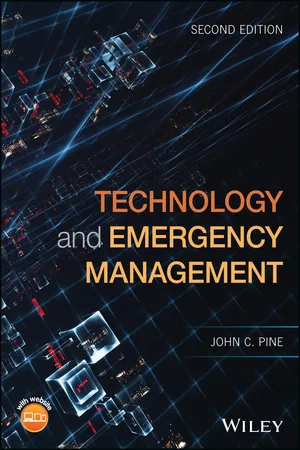
- English
- ePUB (mobile friendly)
- Available on iOS & Android
Technology and Emergency Management
About this book
The first book devoted to a critically important aspect of disaster planning, management, and mitigation
Technology and Emergency Management, Second Edition describes best practices for technology use in emergency planning, response, recovery, and mitigation. It also describes the key elements that must be in place for technology to enhance the emergency management process. The tools, resources, and strategies discussed have been applied by organizations worldwide tasked with planning for and managing every variety of natural and man-made hazard and disaster. Illustrative case studies based on their experiences appear throughout the book.
This new addition of the critically acclaimed guide has been fully updated and expanded to reflect significant developments occurring in the field over the past decade. It features in-depth coverage of major advances in GIS technologies, including the development of mapping tools and high-resolution remote sensing imaging. Also covered is the increase in computer processing power and mobility and enhanced analytical capabilities for assessing the present conditions of natural systems and extrapolating from them to create accurate models of potential crisis conditions. This second edition also features a new section on cybersecurity and a new chapter on social media and disaster preparedness, response, and recovery has been added.
- Explores the role of technology in emergency planning, response, recovery, and mitigation efforts
- Explores applications of the Internet, telecommunications, and networks to emergency management, as well as geospatial technologies and their applications
- Reviews the elements of hazard models and the relative strengths and weaknesses of modeling programs
- Describes techniques for developing hazard prediction models using direct and remote sensing data
- Includes test questions for each chapter, and a solutions manual and PowerPoint slides are available on a companion website
Technology and Emergency Management, Second Edition is a valuable working resource for practicing emergency managers and an excellent supplementary text for undergraduate and graduate students in emergency management and disaster management programs, urban and regional planning, and related fields.
Frequently asked questions
- Essential is ideal for learners and professionals who enjoy exploring a wide range of subjects. Access the Essential Library with 800,000+ trusted titles and best-sellers across business, personal growth, and the humanities. Includes unlimited reading time and Standard Read Aloud voice.
- Complete: Perfect for advanced learners and researchers needing full, unrestricted access. Unlock 1.4M+ books across hundreds of subjects, including academic and specialized titles. The Complete Plan also includes advanced features like Premium Read Aloud and Research Assistant.
Please note we cannot support devices running on iOS 13 and Android 7 or earlier. Learn more about using the app.
Information
1
THE NEED FOR TECHNOLOGY IN EMERGENCY MANAGEMENT
Starting Point
What You’ll Learn in This Chapter
- The definitions of focusing events and windows of opportunity
- The types of technology as applied to the emergency management process
- How technology can assist in emergency preparedness, mitigation, response, and recovery
After Studying This Chapter, You’ll Be Able To
- Examine what technology is used in emergency management.
- Examine what technology tools have been applied during disasters.
- How focusing events can be used to gain community support for greater emergency management resources.
Goals and Outcomes
- To be able to select technology that improves disaster preparedness, response, mitigation, and recovery
- To perform a comprehensive technology needs assessment for emergency management
- To understand the value of encouraging a community to commit greater resources toward emergency management by using focusing events and the needs assessment
INTRODUCTION
1.1 Technology and Disaster Management
- Organizational and personal communication;
- Timely observations of the nature and extent of events;
- Enhancement in capabilities to estimate and model potential outcomes of disaster events;
- Recording the changing nature of response and recovery events;
- Communicating with multiple organizations and individuals simultaneously;
- Analyzing events to understand how disasters evolve and change over time;
- Connecting individuals and organizations so as to enhance communication;
- Extending how public and private organizations may access information as disaster evolve;
- Using mapping and geo‐positioning systems (GPSs) to support situational awareness; and
- Taking advantage of hazard modeling technology to enhance our understanding of both the threats associated with hazards and their potential impacts.
1.1.1 Focus on Current and Emerging Technology
1.2 Technology as a Management Tool
Table of contents
- COVER
- TITLE PAGE
- TABLE OF CONTENTS
- CONCEPT
- ABOUT THE AUTHOR
- LIST OF CONTRIBUTORS
- ABOUT THE COMPANION WEBSITE
- 1 THE NEED FOR TECHNOLOGY IN EMERGENCY MANAGEMENT
- 2 COMPUTER NETWORKS AND EMERGENCY MANAGEMENT
- 3 CYBER SECURITY
- 4 SOCIAL MEDIA AND EMERGENCY MANAGEMENT
- 5 GEOSPATIAL TECHNOLOGIES AND EMERGENCY MANAGEMENT
- 6 DIRECT AND REMOTE SENSING SYSTEMS
- 7 EMERGENCY MANAGEMENT DECISION SUPPORT SYSTEMS
- 8 WARNING SYSTEMS
- 9 HAZARDS ANALYSIS AND MODELING
- 10 OPERATIONAL PROBLEMS AND TECHNOLOGY
- 11 TRENDS IN TECHNOLOGY
- FIGURE CREDITS
- INDEX
- END USER LICENSE AGREEMENT